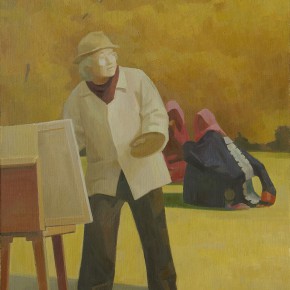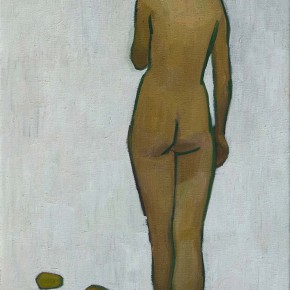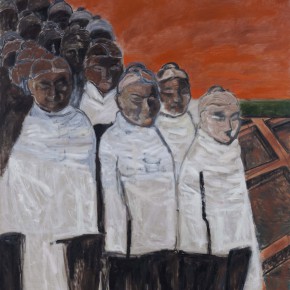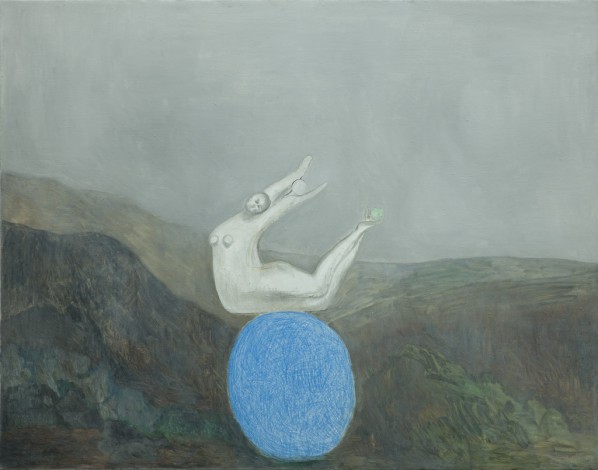
What is painting today? It is a medium said to have died several times over in the last 170-odd years since the remark was first made by a painter confronted with the new invention of photography. Painting today comes in many guises, but a painting is the result of an arrangement of elements, essential components of the world the painter seeks to represent. This world forms a reality that belongs to the individual painter alone. Despite all the shifts in emphasis that have occurred in the style and practice of painting in the last 170-odd years, and all the theories that have been constructed to define its recent evolutionary phases and the anti-aesthetic practices that artists have developed in attempts to reinvent this medium (Bad Painting as one example), artists continue to produce great paintings: paintings that are considered to be “great” because they project a magical web of attraction that works on the viewer’s emotions as much as their eye, defying logic and the rational mind as they do so.
Each of the six artists, Jia Aili, Wang Yin, Zhao Gang, Duan Jianyu, Li Shurui and Qiu Ruixiang, work with a style and language that is recognizably their own and, in their various ways, present narratives and stories, personal experience and broader worldviews. Each demonstrates a precise feel for a particular set of emotions, be that sober, psychological, ethereal or humorous, and a distinctive application of the material of oil paint to accurately reflect their expression. History demonstrates that as long as there are new circumstances and social experiences in the world, there will be subjects for painters to unravel on canvas. This is ultimately seen to best effect in what these six artists do as painting.
About the exhibition
Duration: March 22 -- July 21, 2014
VIP Reception (By Invitation Only): Friday March 21, 4:00-7:30pm
Exhibition Opening: Saturday March 22, 2:00-5:00pm
About the artists
WANG YIN
b.1964
Lives and works in Beijing
The son of a painter, Wang Yin grew up in the midst of “art” from an early age. At the time of his childhood, it was Soviet artists who through Socialist Realism defined the artistic style of the era. As he embarked upon his artistic path, a new cultural awareness was unfolding yet, against this full exposure to avant-garde ideas, as Wang Yin embarked on his career he was particularly drawn to a simple, basic question: how it is that I paint this way? Why is it, Wang Yin, mused, that so many artists found expression in landscapes, figures, portraits and still-lifes – subjects inherently familiar to us as “art” -- through such an extraordinarily long period of art history? This began the artist's engagement with the work of so many other familiar artists -- Paul Cezanne, Georges Seurat and Edward Hopper, and those Soviet artists who were his first enduring influence. As contemporary art critic Wang Ming’an has noted “Wang Yin re-studied the works of early Chinese painters such as Xu Beihong, Yan Wenliang, and Wang Shikuo etc. […] examining their works in the context of the entire Chinese modernist view.”1
This investigation, on-going still today, lies at the core of Wang Yin’s paintings. Yet, Wang Yin also takes what is ultimately, a uniquely Chinese cultural approach. As with traditional painters who turned to the past to comment on the present, Wang Yin’s approach is, as Wang Ming’an has described “simply another approach to discussing the present”, by providing “genealogical and investigative observations on the modern development of culture through painting.”2
1] “How to "Recapture" the Experience of Painting?”, Wang Min'an, May, 2006
2] Ibid.
JIA AILI
b. 1979
Lives and works in Beijing
Since his debut in 2006, Jia Aili has arguably become the most influential artist of his generation. To some, this ascension is curious because, to judge from his material style alone, it is hard to pin down precisely an essential difference that makes his painting distinct from that of so many others we might name. Yet, it is. Due to the training he received at Shenyang’s Lu Xun Academy, and the styles of art to which he has had greatest exposure – again, as with Wang Yin and Zhao Gang, to the Soviet painters of realism -- there is much about Jia Aili’s style that is familiar to viewers today. Less so the content it describes: Jia Aili’s paintings are not, to borrow a phrase from art theorist David Joselit, “vessels for borrowed content”. His vision is his own; his world in the manner that Middle Earth belongs to J. R. R. Tolkien. Yet, in spite of his familiarity with that world, each foray into its distant horizons does not begin with a finite plan. Intuition is his guide and, as one imagines is the case for the children who appear in a number of the paintings, Jia Aili dares to explore, to venture into the unknown, wherever that venturing might lead him.
The paintings seem to depict the destruction of “home” whether by natural disaster or demolition for redevelopment, and a disquiet and anxiety that subvert the normal rhythms of life by exerting an unerring psychological effect. In the manner that Breughal’s Garden of Earthly Delights functioned as a mirror to human society, so the paintings of Jia Aili give new insight into the real world and our own humanity. The only thing we have to fear, it seems, is ourselves.
ZHAO GANG
b.1961
Lives and works in Beijing
Zhao Gang's engagement with art began in Beijing in the late 1970s, as a member of the fledging Stars Group, formed by young idealistic artists at a moment when, in the early days of opening and reform, China was experiencing a wave of renewed possibilities.Like many of the self-taught artists who belonged to the Stars Group, Zhao Gang departed China in the early 1980s to study abroad. He arrived in the Netherlands in 1983, remaining there but a year before transferring to the US, where his career as a painter really began. He returned to China in 2007 following a journey that has been both physical and artistic, and which has seen his style change in myriad ways as the amalgamation of diverse cultural experiences coalesced through space, in the various places he lived, and through time, spent in the very different cultural frameworks he encountered.
In recent years, Zhao Gang’s paintings have taken on a huge scale which has allowed him to give full vent to ideas, emotions, concepts that had clearly been bottled up for some time. A series of landscapes, begun in 2012, play certain ironic tribute to familiar vistas and scenes which, for those familiar with Chinese brush painting, invoke the kind of epic temporal span one can observe in traditional ink painting. They also represent his deepening interest in China’s cultural heritage and his comment upon a thousand year continuum which has become an ingrained concept under which the achievements that make this continuum extraordinary are subsumed to a rhetoric reduced to the level of a slogan. At the same time, Zhao Gang is simply painting: resolving a question that was first posed back in Beijing in the late 1970s as to the relationship between colour and space as the core of all painting. Zhao Gang’s primary concern is to resolve this relationship.
DUAN JIANYU
b.1970
Lives and works in Guangzhou
Duan Jianyu's particular individuality as an artist pivots on the empathetic insight she expresses towards daily life. It has a universal quality open to all viewers, because hers is an essentially human perspective, channelled through an accented reference to the immediate cultural framework in China. As a result of her keen observations, Duan Jianyu is fluent in a vernacular language of expression that, through the recent several decades in contemporary art in China, has been consciously eschewed as artists strove to adopt what was viewed as being a more broadly international approach to content and to social commentary as art. This can be discerned in the various, often incongruous, elements that she brings together in a single composition and to the palette of colour used to achieve a variety of surface textures and painterly finishes that are never just easy or mechanical: “I don’t have a fixed aesthetic format when dealing with oil painting,” she explains. “I mainly look at the kind of sensations are needed to match the topic I am portraying.” The diverse nature of her work attests to the diligence and experimental process brought to this task.
LI SHURUI
b.1980
Live and works in Beijing
Li Shurui is a painter but as an artist her impulses extend beyond conventional two-dimensional canvas painting. She also produces physical objects and installations, using the surface of a physical form or space as an element of visual illusion. This creates a double play on the conventions of using paint to “decorate” a flat area, be that canvas or wall (as mural painting), due to the distinctly decorative aspect of the patterns that her semi-abstract compositions deploy. Specially created for OCAT Xi’an’s second floor exhibition space, An Invitation to View demonstrates Li Shurui’s exploration of painting in three dimensions as a form of installation art. Invitation to View begins from the physical reality of the space it occupies, primarily the dimensions and proportions of the available walls and their physical characteristics. The structural pattern that results thus describes a relationship between various aspects of the actual space and its surface, rationalized to achieve a cohesive whole. Visitors enter Invitation to View and in being surrounded by it are embraced by its subtle aura. Invitation to View is both uniquely site-specific and in harmony with its surroundings.
QIU RUIXIANG
b.1980
Lives and works in Xi’an
Qiu Ruixiang is a young artist native to Shaanxi. His painting style has a rustic simplicity and a sophisticated emotional timbre, neither of which have an obvious correlation with very contemporary approaches to painting. Instead, Qiu Ruixiang’s paintings appear traditional; to belong, even, to a tradition of Western art history that most immediately references the chiaroscuro’d drama of Velasquez and Goya. Qiu Ruixiang makes great use of dark tones from which his subjects emerge as if into daylight from the lightless realm of night or from an unlit interior, with all the accompanying disorientation that is momentarily experienced before the senses normalize for their eyes are almost always closed. The figures Qiu Ruixiang presents are enigmatic. The spaces they inhabit are undefined such that, alone, the figures seem lost and, in the manner of their separation from us, both cut off within an atmospheric fog into which we have no point of entry and, with their eyes closed, looking inward, as if refusing to acknowledge the presence of an onlooker, viewers are never able to draw close to them. Standing in front of Qiu Ruixiang’s paintings you feel as off kilter as his subjects. Qiu Ruixiang’s art has a unique existence in a particular place which is perhaps not the ultimate core of the contemporary yet, for all that, the works are no less relevant to society today.
The exhibition will be accompanied by a lively talks program under the heading “Conversations About Painting”.
Painting and Narrative / Stories: painting as content
Painting and the Individual Worldview: painting as personal expression
Painting and Its Histories: painting in reference to other paintings
Painting and Its Materials: painting as field of internal emotion and spatial experience
Dates to be confirmed: For full details of their talks program follow OCAT Xi’an on:
WeChat: OCT当代艺术中心西安馆
SinaWeibo: @OCT当代艺术中心西安馆
About OCAT Xi’an
OCT Contemporary Art Terminal in Xi’an (OCAT Xi’an) is the latest addition to the OCAT group which was founded in Shenzhen in 2005. Devoted to contemporary art, OCAT Xi’an draws upon local and international resources to promote Chinese contemporary art to an international standard as well as to support international programs in Xi’an.
OCAT Xi’an has three floors, two exhibition areas and one activity centre overseen by a small staff of professional curators and art workers. Our annual program of local and international exhibitions is open to everyone, whether to discover contemporary art for the first time, or to learn more about artists shaping the contemporary art scene.
A Contemporary Contribution to the Grand Cultural Traditions of Xi’an
In the Tang dynasty, China prospered. Xi’an, its capital, was the most cosmopolitan city of the day to be found in Asia. Today, 1300 years on, China prospers again and is enjoying a period of cultural openness, encouraged as part of China’s deepening dialogue with the international community.
With its exhibition program, OCAT Xi’an becomes part of this community. Our program is guided by a contemporary focus on artistic innovations that extend backwards and forwards in time and, geographically, west, embracing cultures along ancient routes that, like China today, are home to ever evolving forms of new artistic expression. It is said that in ancient Xi’an east met west. OCAT Xi’an aims to continue that convergence through the contemporary practices of artists at the forefront of the age.
The History of the OCAT Institutions
The OCT Contemporary Art Terminal (OCAT) was founded in Shenzhen in 2005 as an art centre affiliated with the He Xiangning Art Museum. Guided by the vision of the celebrated art critic Huang Zhuan, OCAT Shenzhen emerged as a dynamic platform for exhibition programs, academic discussions and cultural events in Shenzhen, its influence swiftly extending across the region and to Hong Kong. In 2012, this success was acknowledged with an official decree of independence and the granting of non-profit status, thus allowing OCAT Shenzhen to move forward into a new era of collaboration with international institutions and sponsors, and to provide a greater service to the arts in China.
OCAT Shenzhen is now joined by OCAT Shanghai and OCAT Xi’an, all dedicated to serving the best Chinese and international artists. We pride ourselves on being a broad platform and communication network that focuses on visual art, but includes performance, music, film and video and multimedia arts. OCAT’s professional activities are supported by an international advisory board comprised of leading artists and independent and museum-affiliated curators.
OCAT Xi’an
Address: OCAT Xi’an, Beichitou 1st Road, Yanta District, Xi’an
Telephone: 029-85529730
Email: ocat-xian@ocat.org.cn
Opening Hours: 10:00-17:00, Tuesday to Sunday (last entries 16:30)
Courtesy of the artists and OCAT Xi'an, for further information please visit


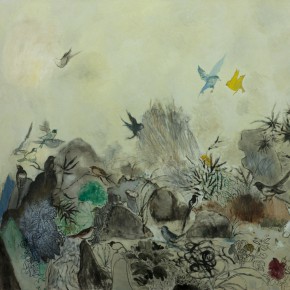
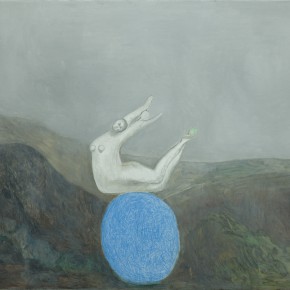
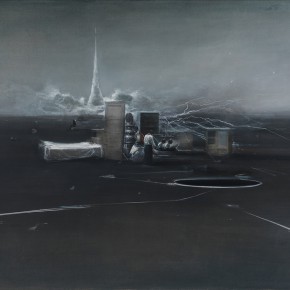

-2014-mural-painting-household-paint-site-specific-work-290x290.jpg)



